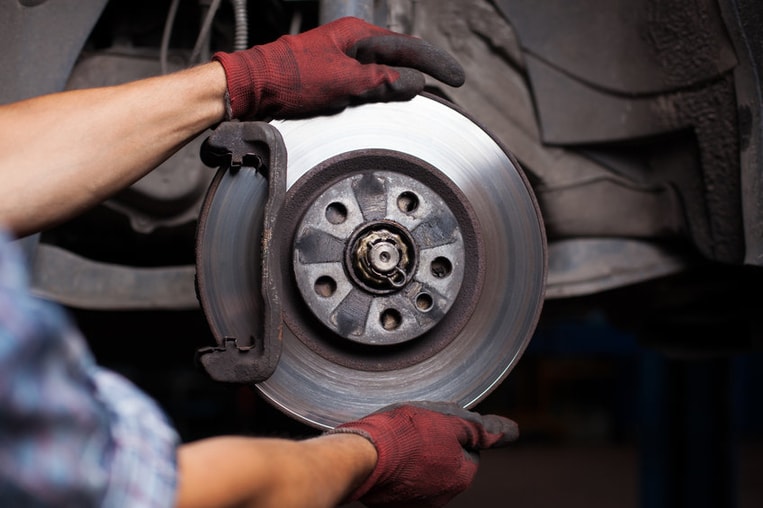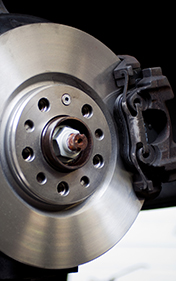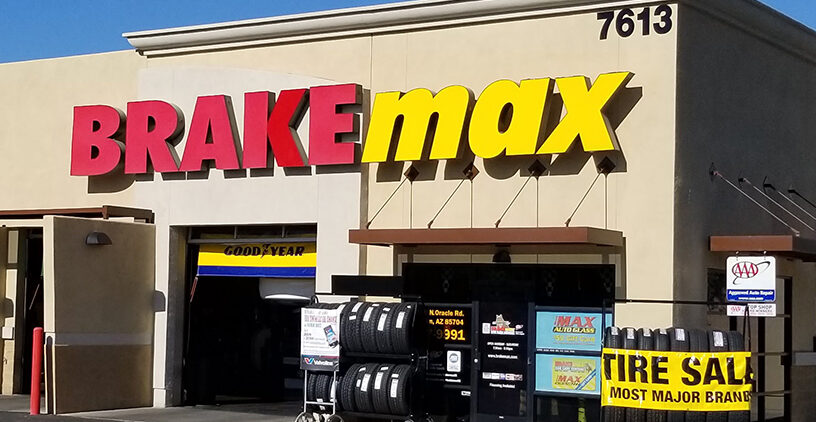Brake Pads & Brake Pad Replacement: Tucson Repair Guide

The importance of the brake system on your vehicles can’t be overemphasized. There are some repairs that can wait until a more convenient time, but a brake repair or brake replacement is not one of them. In order to take care of this essential part of a vehicle, it’s important to know how the brakes work, including one of the critical components, the brake pads.
Components of a Brake System in Passenger Vehicles
The braking system of a vehicle is a complex interplay of these components:
- ABS Control Module: Performs diagnostic checks of the braking system, sending correct pressure to each of the wheels
- Brake Booster: Reduces pressure needed for braking and increases force put on the master cylinder via the brake pedal
- Disc Brakes: Includes brake pads that press on a disc (rotor) when brake pedal applied; pads are attached to a caliper that frames the rotor; usually on front wheels
- Drum Brakes: Has wheel cylinders, shoes, and drum that stop the car when the brake pedal is pressed; located on the rear of the vehicle
- Emergency Brake: Keeps vehicle from rolling away when parked; operates separately from the main brake system.
- Master Cylinder: Converts pressure from non-hydraulic to hydraulic which is used by the wheel cylinders to press brake pads against rotors to stop the car
- Brake Pedal: When the driver steps on the brake pedal to stop the vehicle, a piston in the cylinder moves to complete the action
- Wheel Speed Sensors: Monitors the speed of each tire and sends the info to the ABS control module
The brake pads are an essential part of the entire brake system on cars with a disc brake system. When you need to stop or slow down, the pressure and friction combination when you step on the brake is what causes the pads to press on the rotors. If the pads are worn out or defective, you may end up with brake failure. That’s why it’s important to act quickly to take care of a brake pad replacement or repair.
Now that you know more about how the brake pads work in the entire system, the next question is how to tell when they need to be replaced or repaired.
Signs Your Brake Pads Are in Trouble
Here are some red flags that alert you to problems with the brake pads in your vehicle:
Squealing Noises
If you hear squealing or other unusual noises when you press the brake pedal, it may be the built-in “wear indicator.” Manufacturers put this device on brakes to alert the driver that the pads need to be checked and perhaps replaced.
Clicking Noise
This clicking noise usually signals that the device holding the pad or pads in place has become loose. It makes a rattling or clicking noise and needs to be checked.
“Brake Fade”
You find that it simply takes longer for the car to stop when you press the brake pedal. If you regularly press the brake pedal for longer than normal distances without the car ever having to stop, the pads and the rotor can overheat. This means the mechanism can’t generate the friction needed to stop the car quickly. And since the purpose of the brake system is to stop the car, pay attention!
Pulling to One Side or the Other
Brake pads wear out differently in each position on the car. This causes pulling to one side or the other when you brake. There are other causes for pulling but it needs to be checked out by your BRAKEmax service staff as soon as possible.
Vibration in the Brake Pedal
Brake pads are held together with a resin. Over time, the resin breaks down and can lead to this vibration in the brakes. Let our BRAKEmax brake specialists take a look.
It isn’t worth it to jeopardize your safety by not paying attention to signs of trouble like these. Make an appointment at your BRAKEmax Tire & Service Centers as soon as possible to avoid further damage, unnecessary injury, or worse.
A Schedule for Brake Pad Repair
Brake pads start out with 12mm of the material that produces the friction that stops or slows your car. As a general rule, when you take your car or truck into BRAKEmax for its diagnostic checks, our brake mechanic will suggest replacing the pads when they get to 3 or 4 mm. The one thing we don’t want to see is the rotors being gouged out due to worn brake pads.
Not many drivers, though, actually measure their brake pads. It is important to keep up your schedule of maintenance checks for your car and also to trust your BRAKEmax brake specialists to measure this. Our experts will keep your car on the road safely and can also provide you with advice on protecting your brake pads or replacing them when it is time.
Driving Habits and Brake Pad Materials
Two of the factors that will affect how quickly your brake pads wear out is how you drive your vehicle and what the pads are made of.
Driving Habits
There are some things drivers can do to protect their vehicle’s brake pads from wearing out too quickly:
- Avoid speeding
- Avoid last-minute braking
- Don’t “ride” the brake
- Avoid driving in stop-and-go traffic
- Maximize travel on highways
Of course, the geography of the area where you do most of your driving isn’t something you have much control over. Just be aware that constant braking in hilly areas will wear your pads more quickly, too. In cases like that, it’s especially important to keep up with your brake inspections at BRAKEmax.
Brake Pad Materials
Today, most brake pads are metallic, ceramic, or organic. Each has its advantages and its disadvantages, so being informed and asking your BRAKEmax brake specialist for advice is critical.
Metallic Brake Pads
- Most common today
- Combination of metals and bonding materials
- Very durable
- Economical
- Perform well overall
- Good heat-dissipation properties
Ceramic Brake Pads
- Lightweight
- Durable
- Superb heat dissipation
- Composed of ceramic and sometimes cotton fibers and bonding materials
- Made for high-performance vehicles
- More costly
Organic Brake Pads
- Composed of glass, rubber, or resin
- High heat tolerance
- Environmentally friendly
- Wear down faster than others
The choice may be determined by your vehicle’s needs, how you intend to use the vehicle, or the cost versus value factor. Discuss this with the BRAKEmax service staff in order to get what’s right for your budget as well as your vehicle.
Don’t forget the Coupon Page on the BRAKEmax website! Check often, no matter the need for your car at the moment. The coupons and specials change frequently. We are here to help!
Understanding Your Brakes
As with most anything, having some basic knowledge of a system goes a long way to protecting it. The brake system in your vehicles is critical and grasping how it works, even at a rudimentary level, helps take care of the overall system as well as its various components. The brake pads are one of those parts that cannot be ignored when wearing or failing completely.
Let our BRAKEmax Tire & Service Centers be your first call when you are unsure about the health of your brake pads or any other part of the brake system.
Brake Repair FAQs
How Do I Know If I Need Brake Pads or Brake Rotors?
Because brake pads and brake rotors work together, it’s often hard to tell which part(s) needs attention. If brake pads are becoming too worn to be safe, they will often squeal or squeak. Some cars are equipped with wear indicators that will alert you with a loud noise when the pads need to be checked.
However, if those noises become a grinding sound, the damage has gone past worn pads, and the rotors are being gouged. In addition to being dangerous, the repair will be more expensive. This is why it’s to your advantage to pay attention to new or unusual noises, leaks, pulling, slow stopping, or any other brake problem signs. Have the brakes diagnosed by a highly-skilled BRAKEmax mechanic, who can advise you about the problem and its solution.
How Long Do Brake Pads Usually Last?
Brake pads and shoes usually last between 30,000 and 35,000 miles if the car is usually driven in a city. However, brakes can last up to 80,000 miles or more if the vehicle is driven in less demanding situations, such as highway driving in light traffic. Driver habits also have an effect on brake life. If a driver “rides the brake” as they drive, the brake pads will wear faster.
Other factors account for this wide range. Brake pads come in different types and compositions and are attached to varying brake systems and rotors.
There are three general types of brake pads: metallic, ceramic, and organic. Ceramic brake pads last the longest and give a firmer brake pedal than organic pads. They do not perform quite as well as other pads in extreme cold and are not well-suited for performance use. However, ceramic brake pads are quiet, comfortable, durable, and excellent for daily driving. Organic brake pads wear out faster compared to other types of brake pads. Metallic brake pads don’t last as long as ceramics but longer than organic pads.
How Often Do Brake Calipers Need to Be Replaced?
The brake pads and brake rotors are critical to your car stopping when you press on the brake pedal in the car. However, the brake calipers, which are generally on the front brakes, are also very important to the process.
When you step on the brake pedal, brake fluid causes pressure to be applied to pistons inside the calipers, where the brake pads are housed. This forces the pads against the rotors, creating friction and slowing the car down. The calipers clamp onto the rotor to stop the wheels from turning when you step on the brakes.
Because of the friction generated between the calipers and the pads, heat is also generated. Over time, this heat weakens and breaks down the seals inside the calipers. They can also become rusty or contaminated if you don’t drive regularly. This can cause a leak in the brake fluid.
The brake pads are attached to calipers that frame the rotor and are usually on the front wheels. The brake caliper acts like a clamp on a wheel’s rotor and stops the wheel from turning when the brakes are applied. Calipers are highly resilient and often last for the life of the vehicle. Realistically, they last on average between 75,000 and 100,000 miles, or 10 years.
What Happens If You Don’t Replace Brake Pads
The rotors can explode from getting hot if you don’t pay attention to the red flags that indicate a potential brake pad problem. This can damage other parts of the brake system, leading to a dangerous situation and an expensive repair.
Just as seriously, the vehicle may not stop. The danger in this is obvious and can be deadly.
Should You Replace All 4 Brake Pads at Once?
How Long Does It Take to Change Brake Pads?
When done by expert mechanics, changing brake pads generally takes 30 minutes to one hour.
Some cars, like race cars or heavily modified vehicles, will take longer. There are different size pads to consider for these cars; the pads are made from stronger materials and are harder to change.
For the DIY home mechanic, it’s possible to take on this task yourself. However, as with most such repairs, you may not have all the tools you need or a safe way to work around or under the vehicle. There will also not be any warranty on your work, and the job will take a lot longer. Bring the car to BRAKEmax to ensure your safety, receive a warranty, and get the job done faster.
What Are The Signs Of Worn Brake Pads?
Brake pad replacement is generally done every 25,000–65,000 miles and brake rotors every 30,0000–70,000 miles. The exact number will depend on your driving conditions and habits.
Here Are Five Signs It May Be Time for Brake Repairs.
1. Noises Like Squeaking, Squealing, Clicking, or Grinding
This is one of the first symptoms you may begin to notice. Squealing or squeaking brake pads indicate they are worn down. Some pads have wear indicators that are designed to alert you with a high-pitched squeal each time you step on the brake pedal. If you ignore the wear indicator’s warning, a “metal-on-metal” grinding sound means the brake pad has worn off and the rotors are being damaged. This makes any repair more expensive. Get the brakes inspected as soon as you hear any unusual noises.
2. Vibration or Car Shakes When Braking
The resin that holds brake pads together may be breaking down or the rotors may be warped. Either will cause the brakes to vibrate when the brake pedal is pressed.
3. Longer Stopping Time
Also called “brake fade,” this loss of brake performance means the brake pads are worn completely. It might also mean the brake fluid is low, which may mean a fluid leak. Slow stopping time is extremely dangerous, so have the brakes checked at BRAKEmax as soon as possible. Brake repairs are much less costly when the problem is identified early.
4. Brake Light on Dash Comes On
There are two brake warning lights on the dashboard of most newer vehicles. One is the antilock braking system (ABS) light and the other is the brake system warning light. If the brake system light comes on, first check to see if the parking brake is on. If not, have a brake expert diagnose the issue. If the ABS light illuminates, make an appointment at BRAKEmax to discover the problem.
5. Car Is to One Side or the Other
Just as tires wear differently on each wheel assembly of a car, brake pads wear out differently in each position on the car. When you press the brake pedal, the result is pulling to one side or the other. The pads need to be checked out by your BRAKEmax mechanic as soon as possible.









